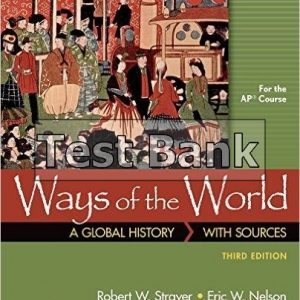Instant download Test Bank for Contemporary Engineering Economics 5th Edition by Park pdf docx epub after payment.

Product details:
- ISBN-10 : 0136118488
- ISBN-13 : 978-0136118480
- Author: Chan S Park
Contemporary Engineering Economics, 5/e, is intended for undergraduate engineering students taking introductory engineering economics while appealing to the full range of engineering disciplines for which this course is often required: industrial, civil, mechanical, electrical, computer, aerospace, chemical, and manufacturing engineering, as well as engineering technology.
This edition has been thoroughly revised and updated while continuing to adopt a contemporary approach to the subject, and teaching, of engineering economics. This text aims not only to build a sound and comprehensive coverage of engineering economics, but also to address key educational challenges, such as student difficulty in developing the analytical skills required to make informed financial decisions.
Table of contents:
xviii
PART 1 BASICS OF FINANCIAL DECISIONS
1(206)
Engineering Economic Decisions
2(18)
Role of Engineers in Business
5(3)
Types of Business Organization
5(2)
Engineering Economic Decisions
7(1)
Personal Economic Decisions
7(1)
What Makes the Engineering Economic Decision Difficult?
8(2)
Economic Decisions Versus Design Decisions
10(1)
Large-Scale Engineering Projects
10(5)
How a Typical Project Idea Evolves
11(3)
Impact of Engineering Projects on Financial Statements
14(1)
A Look Back in 2009: Did Toyota Make the Right Decision?
14(1)
Common Types of Strategic Engineering Economic Decisions
15(1)
Fundamental Principles of Engineering Economics
16(4)
Summary
18(1)
Short Case Studies
19(1)
Accounting and Financial Decision Making
20(38)
Accounting: The Basis of Decision Making
23(1)
Financial Status for Businesses
24(13)
The Balance Sheet
26(4)
The Income Statement
30(4)
The Cash Flow Statement
34(3)
Using Ratios to Make Business Decisions
37(21)
Debt Management Analysis
39(2)
Liquidity Analysis
41(1)
Asset Management Analysis
42(2)
Profitability Analysis
44(2)
Market Value Analysis
46(2)
Limitations of Financial Ratios in Business Decisions
48(1)
Summary
48(1)
Problems
49(7)
Short Case Studies
56(2)
Interest Rate and Economic Equivalence
58(78)
Interest: The Cost of Money
56(12)
The Time Value of Money
60(1)
Elements of Transactions Involving Interest
61(4)
Methods of Calculating Interest
65(2)
Simple Interest versus Compound Interest
67(1)
Economic Equivalence
68(7)
Definition and Simple Calculations
68(3)
Equivalence Calculations: General Principles
71(4)
Development of Formulas for Equivalence Calculations
75(39)
The Five Types of Cash Flows
75(2)
Single-Cash-Flow Formulas
77(8)
Uneven Payment Series
85(4)
Equal-Payment Series
89(12)
Linear-Gradient Series
101(6)
Geometric Gradient Series
107(7)
Unconventional Equivalence Calculations
114(22)
Composite Cash Flows
114(6)
Determining an Interest Rate to Establish Economic Equivalence
120(2)
Unconventional Regularity in Cash Flow Pattern
122(1)
Summary
123(1)
Problems
124(8)
Short Case Studies
132(4)
Understanding Money and Its Management
136(71)
Nominal and Effective Interest Rates
138(8)
Nominal Interest Rates
138(1)
Effective Annual Interest Rates
139(3)
Effective Interest Rates per Payment Period
142(2)
Continuous Compounding
144(2)
Equivalence Calculations with Effective Interest Rates
146(7)
When Payment Period is Equal to Compounding Period
146(1)
Compounding Occurs at a Different Rate than That at Which Payments are Made
147(3)
Compounding is Less Frequent than Payments
150(3)
Equivalence Calculations with Continuous Payments
153(6)
Single-Payment Transactions
154(1)
Continuous-Funds Flow
155(4)
Changing Interest Rates
159(3)
Single Sums of Money
159(1)
Series of Cash Flows
160(2)
Debt Management
162(18)
Commercial Loans
162(8)
Loan versus Lease Financing
170(3)
Home Mortgage
173(7)
Investing in Financial Assets
180(27)
Investment Basics
180(1)
How to Determine Your Expected Return
181(3)
Investing in Bonds
184(8)
Summary
192(1)
Problems
193(10)
Short Case Studies
203(4)
PART 2 EVALUATION OF BUSINESS AND ENGINEERING ASSETS
207(174)
Present-Worth Analysis
208(62)
Describing Project Cash Flows
210(4)
Loan versus Project Cash Flows
210(3)
Independent versus Mutually Exclusive Investment Projects
213(1)
Initial Project Screening Method
214(6)
Payback Period: The Time It Takes to Pay Back
214(3)
Benefits and Flaws of Payback Screening
217(1)
Discounted Payback Period
218(1)
Where Do We Go from Here?
219(1)
Discounted Cash Flow Analysis
220(8)
Net-Present-Worth Criterion
220(4)
Meaning of Net Present Worth
224(2)
Basis for Selecting the MARR
226(2)
Variations of Present-Worth Analysis
228(7)
Future-Worth Analysis
228(3)
Capitalized Equivalent Method
231(4)
Comparing Mutually Exclusive Alternatives
235(35)
Meaning of Mutually Exclusive and “Do Nothing”
235(4)
Analysis Period
239(1)
Analysis Period Matches Project Lives
240(3)
Analysis Period Differs from Project Lives
243(7)
Analysis Period is Not Specified
250(3)
Summary
253(1)
Problems
254(13)
Short Case Studies
267(3)
Annual Equivalent-Worth Analysis
270(50)
Annual Equivalent-Worth Criterion
272(7)
Fundamental Decision Rule
272(3)
Annual-Worth Calculation with Repeating Cash Flow Cycles
275(2)
Comparing Mutually Exclusive Alternatives
277(2)
Capital Costs Versus Operating Costs
279(3)
Applying Annual-Worth Analysis
282(7)
Benefits of AE Analysis
282(1)
Unit Profit or Cost Calculation
283(2)
Make-or-Buy Decision—Outsourcing Decisions
285(2)
Pricing the Use of an Asset
287(2)
Life-Cycle Cost Analysis
289(6)
Design Economics
295(25)
Summary
304(1)
Problems
305(11)
Short Case Studies
316(4)
Rate-of-Return Analysis
320(61)
Rate of Return
322(3)
Return on Investment
323(1)
Return on Invested Capital
324(1)
Methods for Finding the Rate of Return
325(12)
Simple versus Nonsimple Investments
325(2)
Predicting Multiple l’s
327(3)
Computational Methods
330(7)
Internal-Rate-of-Return Criterion
337(14)
Relationship to PW Analysis
337(1)
Net-Investment Test: Pure versus Mixed Investments
337(3)
Decision Rule for Pure Investments
340(2)
Decision Rule for Mixed Investments
342(9)
Mutually Exclusive Alternatives
351(30)
Flaws in Project Ranking by IRR
351(1)
Incremental Investment Analysis
351(8)
Handling Unequal Service Lives
359(4)
Summary
363(1)
Problems
363(15)
Short Case Studies
378(3)
PART 3 ANALYSIS OF PROJECT CASH FLOWS
381(158)
Cost Concepts Relevant to Decision Making
382(46)
General Cost Terms
384(3)
Manufacturing Costs
385(1)
Nonmanufacturing Costs
386(1)
Classifying Costs for Financial Statements
387(3)
Period Costs
387(1)
Product Costs
387(3)
Cost Classification for Predicting Cost Behavior
390(10)
Volume Index
391(1)
Cost Behaviors
391(6)
Cost-Volume-Profit Analysis
397(3)
Future Costs for Business Decisions
400(12)
Differential Cost and Revenue
400(4)
Opportunity Cost
404(2)
Sunk Costs
406(1)
Marginal Cost
406(6)
Estimating Profit from Production
412(16)
Calculation of Operating Income
412(1)
Sales Budget for a Manufacturing Business
412(1)
Preparing the Production Budget
413(2)
Preparing the Cost-of-Goods-Sold Budget
415(1)
Preparing the Nonmanufacturing Cost Budget
416(2)
Putting It All Together: The Budgeted Income Statement
418(2)
Looking Ahead
420(1)
Summary
420(1)
Problems
421(4)
Short Case Studies
425(3)
Depreciation and Corporate Taxes
428(60)
Asset Depreciation
430(2)
Economic Depreciation
431(1)
Accounting Depreciation
432(1)
Factors Inherent in Asset Depreciation
432(4)
Depreciable Property
432(1)
Cost Basis
433(2)
Useful Life and Salvage Value
435(1)
Depreciation Methods: Book and Tax Depreciation
436(1)
Book Depreciation Methods
436(9)
Straight-Line Method
437(1)
Accelerated Methods
438(6)
Units-of-Production Method
444(1)
Tax Depreciation Methods
445(6)
MACRS Depreciation
445(2)
MACRS Depreciation Rules
447(4)
Depletion
451(5)
Cost Depletion
451(2)
Percentage Depletion
453(3)
Repairs or Improvements Made to Depreciable Assets
456(2)
Revision of Book Depreciation
456(1)
Revision of Tax Depreciation
456(2)
Corporate Taxes
458(4)
Income Taxes on Operating Income
458(4)
Tax Treatment of Gains or Losses on Depreciable Assets
462(5)
Disposal of a MACRS Property
462(1)
Calculations of Gains and Losses on MACRS Property
463(4)
Income Tax Rate to Be Used in Economic Analysis
467(5)
Incremental Income Tax Rate
467(3)
Consideration of State Income Taxes
470(2)
The Need for Cash Flow in Engineering Economic Analysis
472(16)
Net Income versus Net Cash Flow
472(1)
Treatment of Noncash Expenses
473(3)
Summary
476(2)
Problems
478(8)
Short Case Studies
486(2)
Developing Project Cash Flows
488(51)
Cost—Benefit Estimation for Engineering Projects
490(2)
Simple Projects
490(1)
Complex Projects
491(1)
Incremental Cash Flows
492(4)
Elements of Cash Outflows
492(1)
Elements of Cash Inflows
493(1)
Classification of Cash Flow Elements
494(2)
Developing Cash Flow Statements
496(19)
When Projects Require Only Operating and Investing Activities
496(4)
When Projects Require Working-Capital Investments
500(5)
When Projects are Financed with Borrowed Funds
505(2)
When Projects Result in Negative Taxable Income
507(4)
When Projects Require Multiple Assets
511(4)
Generalized Cash-Flow Approach
515(24)
Setting up Net Cash-Flow Equations
515(4)
Presenting Cash Flows in Compact Tabular Formats
519(1)
Lease-or-Buy Decision
519(6)
Summary
525(1)
Problems
526(9)
Short Case Studies
535(4)
PART 4 HANDLING RISK AND UNCERTAINTY
539(188)
Inflation and Its Impact on Project Cash Flows
540(42)
Meaning and Measure of Inflation
543(7)
Measuring Inflation
543(5)
Actual versus Constant Dollars
548(2)
Equivalence Calculations under Inflation
550(6)
Market and Inflation-Free Interest Rates
551(1)
Constant-Dollar Analysis
551(1)
Actual-Dollar Analysis
552(4)
Mixed-Dollar Analysis
556(1)
Effects of Inflation on Project Cash Flows
556(9)
Multiple Inflation Rates
560(2)
Effects of Borrowed Funds Under Inflation
562(3)
Rate-of-Return Analysis Under Inflation
565(17)
Effects of Inflation on Return on Investment
565(4)
Effects of Inflation on Working Capital
569(2)
Summary
571(2)
Problems
573(5)
Short Case Studies
578(4)
Project Risk and Uncertainty
582(84)
Origins of Project Risk
585(1)
Methods of Describing Project Risk
585(12)
Sensitivity Analysis
585(6)
Break-Even Analysis
591(4)
Scenario Analysis
595(2)
Probability Concepts for Investment Decisions
597(12)
Assessment of Probabilities
597(5)
Summary of Probabilistic Information
602(3)
Joint and Conditional Probabilities
605(2)
Covariance and Coefficient of Correlation
607(2)
Probability Distribution of NPW
609(15)
Procedure for Developing an NPW Distribution
609(5)
Aggregating Risk over Time
614(6)
Decision Rules for Comparing Mutually Exclusive Risky Alternatives
620(4)
Risk Simulation
624(16)
Computer Simulation
624(1)
Model Building
625(3)
Monte Carlo Sampling
628(6)
Simulation Output Analysis
634(2)
Risk Simulation with Oracle Crystal Ball
636(4)
Decision Trees and Sequential Investment Decisions
640(26)
Structuring a Decision-Tree Diagram
640(4)
Worth of Obtaining Additional Information
644(4)
Decision Making after Having Imperfect Information
648(5)
Summary
653(1)
Problems
654(9)
Short Case Studies
663(3)
Real-Options Analysis
666(61)
Risk Management: Financial Options
668(6)
Features of Financial Options
668(2)
Buy Call Options when You Expect the Price to Go Up
670(2)
Buy Put Options when You Expect the Price to Go Down
672(2)
Option Strategies
674(5)
Buying Calls to Reduce Capital That is at Risk
674(3)
Protective Puts as a Hedge
677(2)
Option Pricing
679(14)
Replicating-Portfolio Approach with a Call Option
679(4)
Risk-Free Financing Approach
683(1)
Risk-Neutral Probability Approach
People also search:
Contemporary Engineering Economics 5th Edition
Contemporary Engineering Economics 5th Edition pdf
Contemporary Engineering Economics
contemporary engineering economics 6th edition solution manual pdf
|
contemporary engineering economics |





